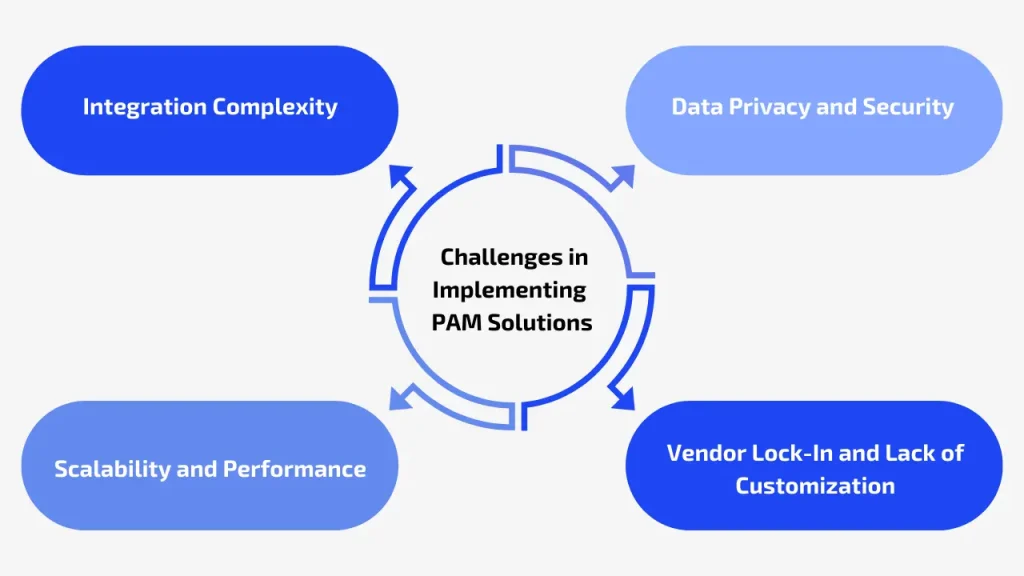Navigating iGaming PAM Solutions: Key Trends, Challenges, and Growth Opportunities

The online gambling industry has undergone a great transformation in the past few years as crypto casinos have taken the world by storm. Casino software platforms now accept cryptocurrencies, including Bitcoin, Ethereum, and Litecoin.
Table of Contents
Brief Overview Of The iGaming Industry Landscape
Driven by the rise of mobile gaming, changing rules, and rising player demand for flawless digital experiences, the iGaming sector has seen tremendous development in recent years. The demand for strong backend infrastructure has never been higher as operators enter new areas and competitiveness gets fiercer. The Player Account Management (PAM) system, a fundamental platform covering everything from player registration and authentication to wallet management, compliance, and tailored interaction, sits at the core of this architecture. A well-executed iGaming PAM system improves player retention and lifetime value as well as operational efficiency and regulatory conformance. Examining the main trends influencing iGaming PAM solutions, the difficulties operators encounter in deployment and optimisation, and the strategic possibilities for those that properly use them, this paper explores their changing terrain.
Current Market Stats
Future projections indicate that the market could grow to $125.6 billion by 2027. Some projections even indicate it could soar to $583.69 billion by 2030.
What is a PAM Solution?
A Player Account Management (PAM) solution is the backbone of any gaming operation, serving as the centralized system that manages all player-related activities and data. At its core, a PAM system handles player registration, account verification, wallet management, and transactional operations. Beyond these fundamental purposes, it is very important in helping major corporate goals, including user acquisition, retention, compliance, and personalisation. PAM guarantees regulatory compliance in several countries by combining instruments, including KYC (Know Your Customer) and AML (Anti-Money Laundering) systems. Through built-in CRM capabilities, loyalty programs, and segmentation tools, which let operators provide customised experiences to many player profiles, it also promotes marketing and consumer interaction. Additional components often include risk management, real-time analytics, reporting dashboards, and integrations with third-party services such as game providers, payment gateways, and affiliate platforms. In essence, a well-designed PAM system not only powers day-to-day operations but also acts as a strategic
Key Trends in iGaming PAM Solutions

Player Account Management (PAM) systems are changing to satisfy the growing needs of operators and players as the iGaming sector develops. Driving invention and establishing new benchmarks for performance, adaptability, and compliance, many major trends are determining the direction of PAM systems.
-
Modular and API-First Architectures
Modern operators demand agile and scalable systems that can adapt to different markets and business models. PAM providers are responding with modular, API-first architectures that allow operators to pick and choose the components they need, and easily integrate third-party services like game content, payment gateways, and analytics tools. Along with accelerating time to market, this strategy future-proofs platforms against changing tech stacks and legislative changes.
-
AI-Driven Personalization
One of the main differences in player interaction now is personalising. To examine real-time player data, PAM systems are progressively using artificial intelligence and machine learning, therefore enabling operators to build very customised user experiences. From recommending games to offering dynamic bonuses and gamification features, AI enables more intelligent segmentation and predictive analytics, improving retention and maximizing lifetime value.
-
Regulatory and Compliance Enhancements
Compliance is always difficult since laws vary greatly among countries. Leading PAM systems today include geo-targeted compliance modules that automatically change player experiences depending on local laws. Built-in KYC/AML checks, automated document scans, and real-time fraud tools help operators stay compliant and onboard users quickly and smoothly.
-
Cross-Platform and Omnichannel Support
Players today expect seamless gameplay across devices and channels—whether they're on mobile, desktop, or at an in-person location. PAM systems can surpass expectations by working across platforms and keeping a consistent player profile everywhere. This unified viewpoint not only improves support and insights but also enables operators to provide flawless, tailored experiences.
-
Blockchain and Crypto Integration
While still emerging, blockchain is making its way into PAM solutions for enhanced transparency and security. Some platforms are beginning to offer support for crypto wallets, smart contracts, and decentralized identity verification. These features appeal to a new generation of tech-savvy players and can help operators expand into markets with strong crypto adoption.
Together, these trends are redefining what a PAM system can do, not just as a backend necessity, but as a strategic driver of growth and innovation in the competitive iGaming ecosystem.
Major Challenges in Implementing PAM Solutions

- Integration Complexity :
One of the most common hurdles is integrating a new iGaming PAM platform with existing legacy systems. Many operators already have tech stacks in place, and aligning those with a new PAM solution can be technically demanding and time-consuming. The process often requires custom development, migration of large datasets, and ensuring that third-party tools, like payment providers or game engines, continue to function smoothly.
- Data Privacy and Security :
With increasingly strict regulations such as GDPR in Europe and CCPA in the U.S., data privacy has become a top priority. Built with compliance in mind, a modern iGaming PAM platform needs to have security data storage, encryption, and access restrictions. Not meeting these criteria compromises brand reputation in addition to subjecting one to large fines. Furthermore, operators need PAM solutions with improved fraud detection and data breach mitigating techniques as cyber threats get more sophisticated.
- Scalability and Performance :
The iGaming PAM platform must be able to scale without sacrificing performance as player bases rise and worldwide expansion picks up speed. High concurrent user counts—especially during peak events—can tax system resources. To guarantee flawless user experiences, operators must have platforms with strong load balancing, high availability, and dynamic scale depending on demand.
- Vendor Lock-In and Lack of Customization :
Some PAM providers offer closed ecosystems that limit flexibility, leading to issues with vendor lock-in. This might discourage creativity and restrict operators from personalising the platform to fit particular market or player needs. Forward-looking operators are looking for open, modular iGaming PAM systems that provide API-based integration, therefore allowing them the opportunity to customise the system to their particular corporate objectives and quickly react to market developments.
Dealing with these issues successfully calls for a forward-looking strategy to scalability, compliance, and innovation combined with careful planning and the appropriate technology partner.
Growth Opportunities and Competitive Advantages
The correct iGaming PAM program can open major development prospects and give operators a long-lasting competitive edge as the iGaming scene becomes more competitive and worldwide. Using the adaptability and strength of modern PAM solutions can help companies not only satisfy present needs but also set themselves up for long-term success.
-
Localization and Emerging Markets
Growing into new areas calls for a thorough awareness of regional tastes, cultural quirks, and legal systems. Modern iGaming PAM systems let operators localise content, payment choices, language, and compliance rules for particular areas, including LatAM, Africa, and Southeast Asia. This flexibility lets operators join new countries fast without compromising full compliance or a suitable player experience.
-
Responsible Gaming Tools
Integrated features for self-exclusion, deposit limitations, session tracking, and real-time behavioural monitoring have become critical as public and legal attention on responsible gambling increases. Leading iGaming PAM software includes these features natively, helping operators build player trust, reduce harmful behavior, and demonstrate a commitment to ethical gaming practices—all of which contribute to stronger brand loyalty and longer player lifecycles.
-
Advanced Analytics & Business Intelligence (BI)
Data is one of the most valuable assets in iGaming, and modern PAM systems harness this through real-time analytics and BI dashboards. With powerful iGaming PAM software, operators can gain insights into player behavior, segment audiences, track performance, and optimize everything from marketing campaigns to bonus structures. This data-driven approach leads to better decision-making and improved customer acquisition and retention strategies.
-
White Label and Turnkey Opportunities
For startups or operators entering regulated markets for the first time, white label and turnkey solutions powered by flexible iGaming PAM software present a fast and cost-effective entry strategy. These solutions offer a ready-made infrastructure including licensing, gaming content, and payment connections that let new firms start with little money and risk, still retaining a high degree of customisation.
Would you like to explore more about iGaming?
Choosing the Right PAM Partner
Choosing the best iGaming PAM provider is a strategic choice that may either create or destroy an operator’s long-term viability. Key factors include provider capacity to provide multi-jurisdictional compliance, platform scalability, customer support availability, and open API ease of integration. Potential suppliers should be asked by operators about uptime assurances, data migration policies, customising choices, and future feature development road plan.
Furthermore, one should consider the advantages and drawbacks of out of the box platforms against tailored solutions. The former gives more freedom, but the latter might drastically cut time to market. The ideal iGaming PAM tool is ultimately one that fits the objectives of the operator, conforms to evolving rules, and enables the company to develop and expand at mass capacity. Having the correct partner, like Tecpinion, will help you to keep ahead of the curve and boldly negotiate the changing digital gaming terrain.
Future Outlook
Rapid technical developments, growing regulatory complexity, and changing player expectations are helping to define iGaming PAM software development going forward. Operators and technology providers both have to be ahead of the curve as the sector changes to be competitive and compliant. Web3 technologies’ inclusion into the PAM ecosystem is among the most important forces behind change. Fresh prospects for openness, fairness, and player control are arising from blockchain-based transaction monitoring, smart contract capabilities, and decentralised identity verification. iGaming PAM software development will probably concentrate on implementing these technologies into main features as they emerge, so operators may stand out in a market growingly congested. As AI models become more sophisticated, expect to see PAM solutions that adapt in real time to player behavior, improving retention and reducing churn.
Globally, compliance rules are becoming increasingly scattered and localised on the regulatory front, which forces operators to react fast or risk penalties. As laws vary across countries, future-ready iGaming PAM systems will have to enable dynamic compliance tools adept at real-time updating. Meanwhile, consolidation among iGaming tech providers is reshaping the vendor landscape. Mergers and acquisitions are creating fewer but more powerful platforms, offering end-to-end solutions under one roof. This trend will influence the direction of iGaming PAM software development, with a focus on interoperability, API-driven ecosystems, and greater modularity to accommodate operators of all sizes.
Future innovation areas include biometric identification, behavioural analytics, and immersive UX elements will keep redefining PAM system capabilities. Operators that invest in forward-thinking, scalable iGaming PAM software development will be better positioned to lead the next wave of growth in the digital gambling space.
Conclusion
Strong and flexible PAM systems are more than simply a behind-the-scenes tool in the fast-changing and regulated iGaming sector of today; they are essential for success. By means of tailored experiences and smart insights, it helps fulfil regulatory obligations, maintain player data security, and increase involvement. Operators have to pick their iGaming PAM software providers carefully as competition rises and marketplaces are more fractured. The correct partner can provide innovative technologies, scalability, support, and ideas required to flourish over time.
At Tecpinion, we specialize in iGaming PAM software development, offering modular, API-driven, and fully customizable solutions that empower operators to launch, scale, and confidently optimize their platforms. Whether you’re entering a new market, looking to enhance player engagement, or needing to ensure airtight regulatory compliance, Tecpinion provides end-to-end support to help you turn your PAM system into an actual growth tool. In the end, operators should see their PAM as a dynamic development enabler rather than a fixed infrastructure component able to open new markets, improve player experiences, and drive sustainable corporate expansion.
FAQ
1. What is a Player Account Management (PAM) system in iGaming?
The foundation of an iGaming platform, a PAM system manages user accounts, handles wallet and payment systems, player verification, bonus systems, and more. It is the central hub guaranteeing compliance, security, and flawless user experience and linking all gaming operations.
2. Why is PAM so critical in today’s iGaming environment?
PAM is essential because it handles all core player data, security protocols, and regulatory requirements and integrates with third-party systems. A robust PAM ensures seamless user journeys, boosts retention and supports scalability for operators.
3. How do PAM providers support regulatory compliance?
PAM systems help automate compliance with features like real-time reporting, player verification, responsible gaming tools, and configurable jurisdictional rules. They ensure operators meet local and international gaming laws efficiently.
4. How does a modern PAM solution drive business growth?
Modern PAM systems increase acquisition, retention, and player lifetime value by streamlining operations, improving user experience, and allowing targeted marketing—all of which let operators concentrate on innovation and growth.
5. Are there opportunities for innovation in PAM systems?
Yes—emerging technologies like blockchain for identity verification, AI-driven personalization, predictive analytics, and deeper social gaming features are transforming the future of PAM systems.
6. How does PAM support responsible gaming?
PAM systems help operators uphold responsible gaming practices and build trust with players and regulators through configurable limits, self-exclusion tools, behaviour tracking, and automated alerts.
7. Can PAM systems be customized for niche markets or brands?
Absolutely. Leading PAM solutions offer modular configurations that can be tailored for specific geographies, game types, or business models—sportsbook, casino, lottery, or emerging verticals.
Want to know more
about iGaming
Read out the Related Blogs
Recent Post
-
What is Casino Software? A Complete Guide
-
Navigating iGaming PAM Solutions: Key Trends, Challenges, and Growth Opportunities
-
Online gambling Industry: What to expect in 2025
-
Are All Sweepstakes Casinos Social Casinos? Debunking Common Misconceptions
-
Why Multi-Language Support is Essential for Online Casino Affiliate Success in 2025

